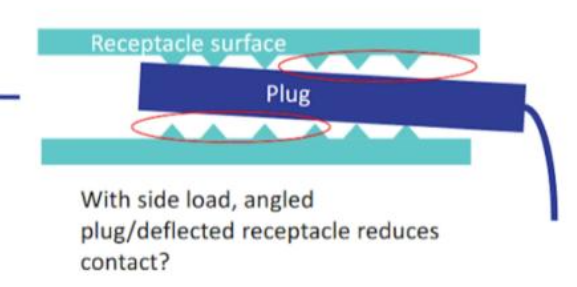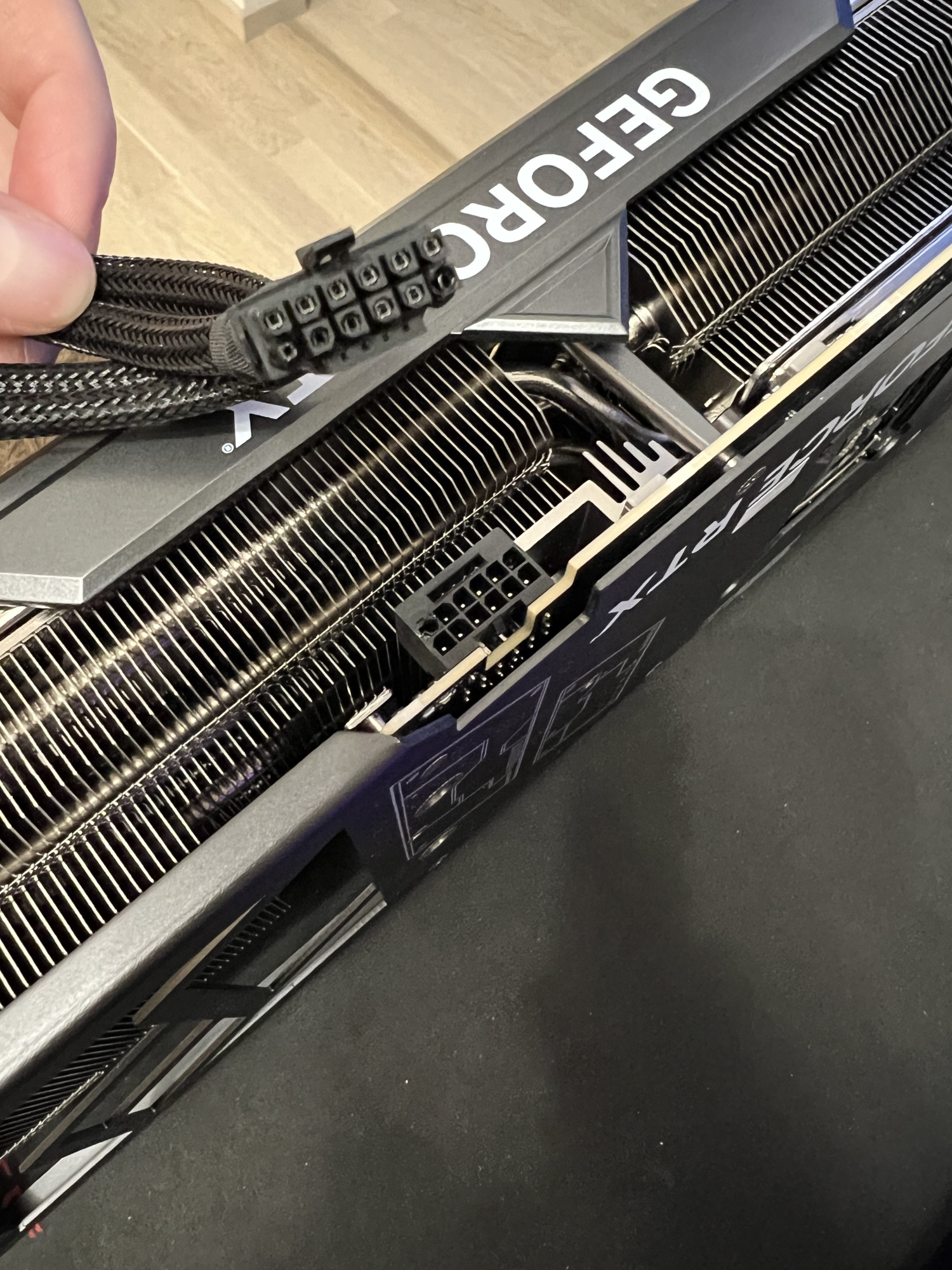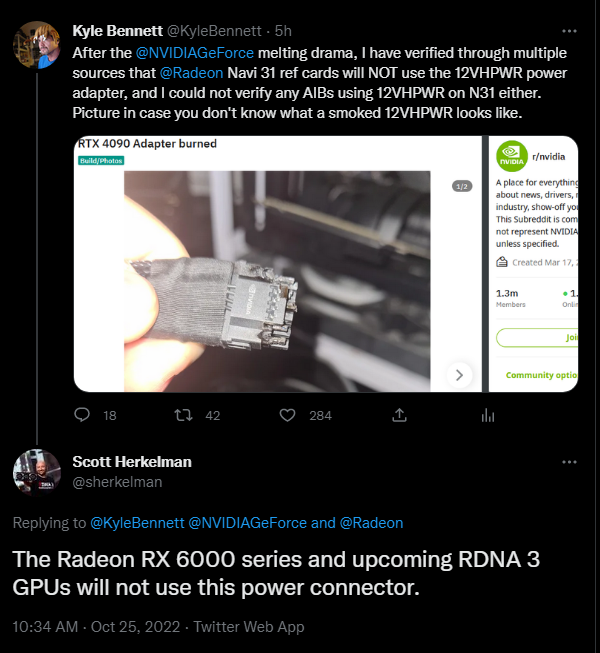TaintedSquirrel
[H]F Junkie
- Joined
- Aug 5, 2013
- Messages
- 12,691
RTX 4050 box at Galax event.
Follow along with the video below to see how to install our site as a web app on your home screen.
Note: This feature may not be available in some browsers.
RTX 4050 box at Galax event.
Yes indeed interesting, practical no when water cooling just seems so much more efficient at higher power designs. Not sure what this design was for, specific aim, maybe it made sense for that.
900W heatsink.
Probably more the rumored cancelled Titan from my understanding no talk of cancelled TI, there so much room on that 4090 chips (only 16384 of the 18176 core are used) and so much room on the power-cooling on the already shipped model that they just have to unlock them to have something they call a 4090TI without changing anything else, the upcoming 24 gddr6x being a nice bonus over that.That must be for the rumored cancelled Ti.
Probably more the rumored cancelled Titan from my understanding no talk of cancelled TI, there so much room on that 4090 chips (only 16384 of the 18176 core are used) and so much room on the power-cooling on the already shipped model that they just have to unlock them to have something they call a 4090TI without changing anything else, the upcoming 24 gddr6x being a nice bonus over that.
The cancelled Titan would have been a 48 GB version like previous Titan way out of touch with gaming requirement.
And 11-1% more core and ram bandwidth 4090 TI released before the end of 2024 depending on what RDNA 3 top model do seem written on the wall.
We don't yet know if this is a widespread problem or a few people on the internet. If it's anything like the Turing memory problems it will be well reported I'm sure.To be fair, there shouldn't be any issues with the 12vhpwr connector itself. It's just that stupid cable Nvidia supplies with their cards. Although that means everyone would have to buy custom PSU cables just to avoid a fire hazard which is an awful look for Nvidia.
The connector is actually the problem. The wires pull on the connector terminals causing those to not seat "perfectly." I guess if we lived in a world where no one that builds a PC has to do cable routing...To be fair, there shouldn't be any issues with the 12vhpwr connector itself. It's just that stupid cable Nvidia supplies with their cards. Although that means everyone would have to buy custom PSU cables just to avoid a fire hazard which is an awful look for Nvidia.


The connector is actually the problem. The wires pull on the connector terminals causing those to not seat "perfectly." I guess if we lived in a world where no one that builds a PC has to do cable routing...
View attachment 521243
I haven't seen one yet, but are they actual pins smaller? The pins appear to be the same size, but they're closer together than the old style, which means that there's less plastic structure to keep them properly aligned.Those pins are just way to small for the amperage they are being asked to carry. A engineering computer might say they are big enough, but the real world disagrees. I have a feeling Nvidia did not rigorously test these connecters in real world conditions.
I haven't seen one yet, but are they actual pins smaller? The pins appear to be the same size, but they're closer together than the old style, which means that there's less plastic structure to keep them properly aligned.
You're clearly right, though, that they didn't test this well enough under real world conditions.

55.2A spread across 6 power pins means each one is carrying around 9.2A. Nowhere close to 15A.I have to go by pictures I have seen, have not seen one in person, but they look similar to what we used in the automotive trade and we don't push more then 15 amps on those size pins. They tend to expand with heat and thus contact starts to degrade which causes overheating due to increasing resistance.
55.2A spread across 6 power pins means each one is carrying around 9.2A. Nowhere close to 15A.
The only way to get the exact specifications is to be a member of PCI-SIG. I would say it's safe to assume it is considering it was a consistent 4.5A across the 3 power pins on the previous cable spec.Your assuming even draw across the pins, they likely are not setup that way.
Well, there you go.
So the issue would still exist even when using an ATX 3.0 PSU?
Pure speculation or informed opinion ?On an ATX 3.0 PSU you would probably end up with the connector on the end of the modular 12VHPWR cable that plugs into your PSU burning up also.
The PCI-SIG report is based upon Nvidias own findings on the PSU side. Problem exist on both sides of the connector, since its the risk of sideloading thats reported as the major problem as shown with FrgMstrs post and earlier post in this thread. There has been a lot of discussions about the connection cycles, but the main issue have always been bending. If a pin is not straight inside the connector, it increases resistance on that pin which again produces heat.Pure speculation or informed opinion ?
If I understand this correctly:
https://wccftech.com/atx-3-0-12vhpw...r-safety-risk-using-adapter-confirms-pci-sig/
They saw unbalanced load on adapter being used that maybe you do see otherwise.
the cable of Nvidia is supposed to help regulate the draw by those 4 cable but not sure we can assume it work has well has direct GPU-PSU no ?
The PCI-SIG report is based upon Nvidias own findings on the PSU side. Problem exist on both sides of the connector, since its the risk of sideloading thats reported as the major problem as shown with FrgMstrs post and earlier post in this thread. There has been a lot of discussions about the connection cycles, but the main issue have always been bending. If a pin is not straight inside the connector, it increases resistance on that pin which again produces heat.
Perhaps if they reinforced the connector a bit stronger beyond the tape and shrink tube approach, it might avoid the issue?
On the PSU side, perhaps they should make it non-modular, since space is often limited for PSU connectors in many cabinets and bending is a must for many?
From my understanding, when it increase resistance it reduce current instead on that pin and make more current goes on the lower resistance pin which would be the one overheating and thus my question if the ATX 3.0 rating PSU would accept that load imbalance, deliver high level unbalanced amperage between them or prefer to refuse to deliver the power instead detecting the issue, the answer to this can be no obviously and if people know that it is the case they know and can say it.. If a pin is not straight inside the connector, it increases resistance on that pin which again produces heat.
The other way around. The 12-pin that NVIDIA introduced with the Ampere generation was a forward-compatible interim solution until ATX 3.0 spec products were available. The PCI-E 5.0 16-pin power specification was available back in 2019.Did Nvidia "invent" this connector and the PCIe standards group adopt it? Or the other way around?
But to me, this seems like an issue of sloppy tolerances and manufacturing. The smaller pins and plastic warrant a plastic that is more dimensionality stable at higher temperatures and a beefier and robust female pin recptiacle
Lol the source for that article is in this thread.Not sure if this was linked yet, but AMD has confirmed they will use 8-pin connectors for the 7000 series cards.
https://wccftech.com/amd-wont-use-gen5-16-pin-12vhpwr-power-connector-on-radeon-rx-7000-rdna-3-gpus/